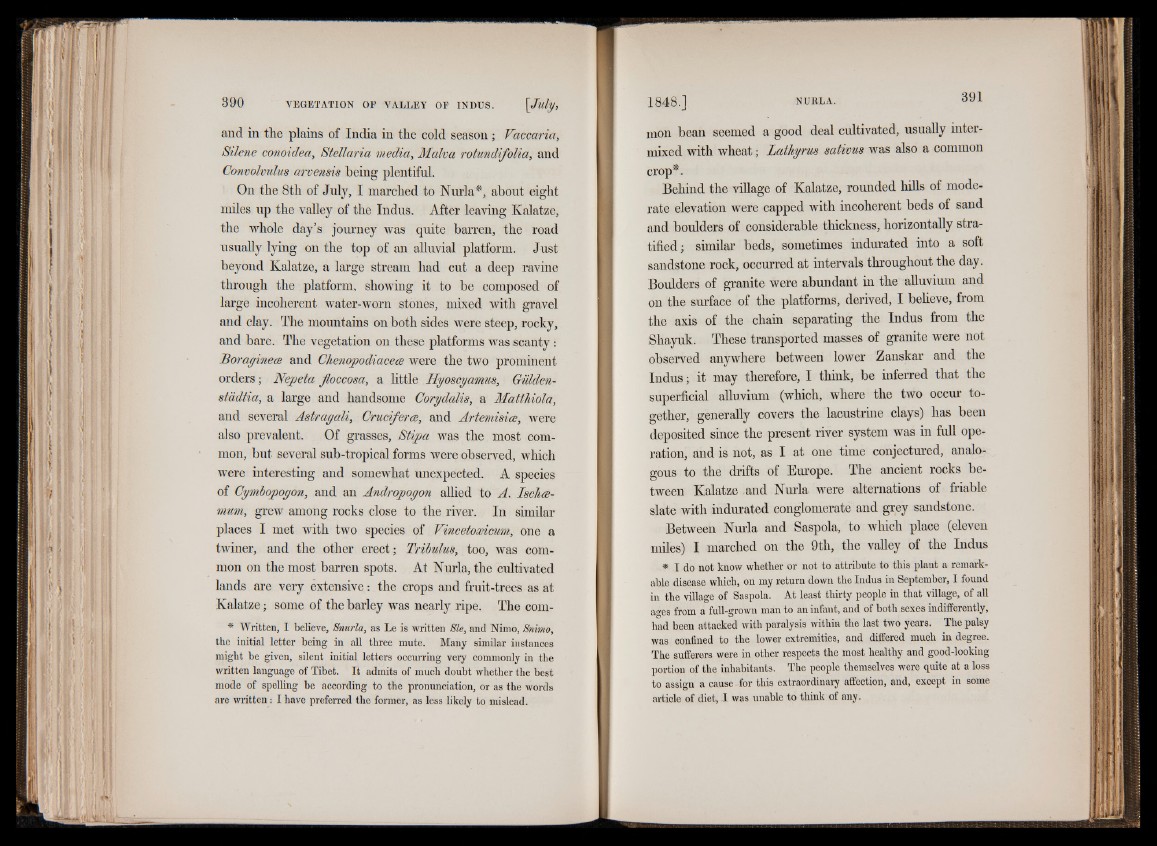
and in the plains of India in the cold season ; Vaccaria,
Silene conoidea, Stellaria media, Malva rotundifolia, and
Convolvulus arvensis being plentiful.
On the 8th of July, I marched to Nuria*, about eight
miles up the valley of the Indus. After leaving Kalatze,
the whole day’s journey was quite barren, the road
usually lying on the top of an alluvial platform. Just
beyond Kalatze, a large stream had cut a deep ravine
through the platform, showing it to be composed of
large incoherent water-worn stones, mixed with gravel
and clay. The mountains on both sides were steep, rocky,
and bare. The vegetation on these platforms was scanty ?
Boraginece and Chenopodiacece were the two prominent
orders; Nepeta Jloccosa, a little Hyoscyamus, Gidden-
stadtia, a large and handsome Corydalis, a Matthiola,
and several Astragali, Cruciferce, and Artemisice, were
also prevalent. Of grasses, Stipa was the most common,
but several sub-tropical forms were observed, which
were interesting and somewhat unexpected. A species
of Cymbopogon, and an Andropogon allied to A. Ischee-
mum, grew among rocks close to the river. In simiW
places I met with two species of Vincetoxicum, one a
twiner, and the other erect; Tribulus, too, was common
on the most barren spots. At Nuria, the cultivated
lands are very extensive: the crops and fruit-trees as at
Kalatze; some of the barley was nearly ripe. The com-
* Written, I believe, Smrla, as Le is written Sle, and Nimo, Snimo,
the initial letter being in all three mute. Many similar instances
might be given, silent initial letters occurring veiy commonly in the
written language of Tibet. It admits of much doubt whether the best
mode of spelling be according to the pronunciation, or as the words
are written : I have preferred the former, as less likely to mislead.
mon bean seemed a good deal cultivated, usually intermixed
with wheat; Lathyrus sativus was also a common
crop*.
Behind the village of Kalatze, rounded hills of moderate
elevation were capped with incoherent beds of sand
and boulders of considerable thickness, horizontally stratified;
similar beds, sometimes indurated into a soft
sandstone rock, occurred at intervals throughout the day.
Boulders of granite were abundant in the alluvium and
on the surface of the platforms, derived, I believe, from
the axis of the chain separating the Indus from the
Shayuk. These transported masses of granite were not
observed anywhere between lower Zanskar and the
Indus; it may therefore, I think, be inferred that the
superficial alluvium (which, where the two occur together,
generally covers the lacustrine clays) has been
deposited since the present river system was in full operation,
and is not, as I at one time conjectured, analogous
to the drifts of Europe. The ancient rocks between
Kalatze and Nuria were alternations of friable
slate with indurated conglomerate and grey sandstone.
Between Nuria and Saspola, to which place (eleven
miles) I marched on the 9th, the valley of the Indus
* I do not know whether or not to attribute to this plant a remarkable
disease which, on my return down the Indus in September, I found
in the village of Saspola. At least thirty people in that village, of all
a„-es from a full-grown man to an infant, and of both sexes indifferently,
had been attacked with paralysis within the last two years. The palsy
was confined to the lower extremities, and differed much in degree.
The sufferers were in other respects the most healthy and good-looking
portion of the inhabitants. The people themselves were quite at a loss
to assign a cause for this extraordinary affection, and, except in some
article of diet, I was unable to think of any.